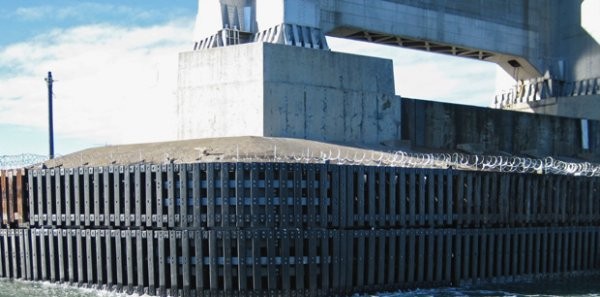Synthetic lumber made from recyclables proves extremely durable

When it opened in 1936, the Bay Bridge for the first time connected residents of San Francisco and Oakland through a daring engineering feat that cost USD 77 million. Two suspended spans, each more than 1.5 kilometers long, whisked cars and (initially) trains across the San Francisco Bay, replacing the ferries that used to ply the choppy waters. Traffic soon surged past expectations, rising from 9 million vehicles the first year to more than 102 million today.
On the morning of November 7, 2007, dense fog shrouded the famous San Francisco Bay Bridge when the Cosco Busan, a 250-meter-long container ship, slammed into the base of one of the bridge’s support towers. The accident caused a major oil spill and tore a huge gash in the vessel’s hull, but the massive Bay Bridge itself, linking the business and transportation hubs of San Francisco and Oakland in California’s Bay Area, took the collision in its stride, thanks in part to a Trelleborg innovation that gives recycled materials a renewed lease on life.
The protective fenders girding the piers rising from the bay had recently been replaced with an innovative, durable and shock-absorbent synthetic lumber made by Trelleborg. SeaTimber is produced from 100 percent recycled HDPE, or high-density polyethylene – which in its previous life may well have been a milk container that ended up in a recycling bin.
“The plastic upgrade proved invaluable to the environment,” says Mick Langford, Sales Manager for Trelleborg Marine Systems USA, a unit within Trelleborg Engineered Systems. “Had the Bay Bridge fenders still been original wood, they would have been in an advanced state of deterioration and would have offered almost no real protection,” he explains. “Plastic may have prevented the worst, which could have been a catastrophic collapse of the bridge.”
According to Trelleborg, SeaTimber and its vertical cousin, SeaPile, are ideal choices when it comes to renovating and shoring up bridge piers, ports and marinas around the world. One reason for this is that the synthetic logs can be manufactured in different measures of flexibility as well as different lengths and colours. In addition, unlike wood, they are not susceptible to rotting in the water or falling prey to marine borers. That is good for the environment, as they don’t have to be treated with creosote and other toxic materials that leach into the water over time. SeaTimber also has a lifespan of 40 to 50 years compared with five to 10 years for wood.
“Not only is it a green alternative, it’s also much more flexible and therefore able to absorb and deflect energy,” says Langford. “The very first major installation was at the port of New Orleans. Over time, more and more people started using it, once they looked at the life-cycle cost benefits.”
The advantages of plastic sheathing was part of what swayed Caltrans, the California Department of Transportation, in the summer of 2005 to replace the more than 11 kilometers of wooden timbers, previously forming the fenders around the base of the Bay Bridge towers, with SeaTimber.
California Engineering Contractors (CEC) carried out the USD 6 million project, choosing SeaTimber in part because of the material’s versatility, says CEC Project Manager Robert Ikenberry. In addition, he says: “SeaTimber won because of the cost analysis, Trelleborg’s track record and their ability to perform to our schedule.”
The upgraded protective layer had weathered three winters in the splash zone when the Cosco Busan accident put it to the test.
“It performed just as it should,” says Ikenberry. “It took the blow for the bridge and protected the infrastructure behind it.” Ikenberry recalls that his phone started ringing off the hook the morning of the collision.
“Caltrans scheduled 100 working days for emergency repairs,” Ikenberry explains. “That was already an unheard-of deadline But thanks to Trelleborg and lots of highly motivated workers all across the U.S., we got it done in less than 30 days. The collaboration was outstanding.”
The project involved rush-producing SeaTimber and the steel struts and arcs that sit behind the fenders. They were then trucked cross-country, so that Ikenberry’s floating crew could install the replacements at Tower 5 on the Bay Bridge’s western span before the winter storms closed in.
On December 15, 2007 the repairs were completed in record time, pressing a few thousand more milk jugs into service for a second time.
Trelleborg also provides products and solutions for the safe berthing and mooring of ships within ports and harbors, on terminals and in waterways around the world. Besides buoys, marine protection and fender systems, the product range also includes laser docking aids, mooring load monitoring, quick release mooring hooks and GPS pilot berthing aids. Numerous hoses, composite bearings, antivibration and sealing solutions are also featured throughout a ship’s equipment and machinery.
Trelleborg AB
Company info
P.O. Box 153
Johan Kocksgatan 10
Trelleborg,
SE, 231 22
Website:
trelleborg.com/en
Phone number:
+46 410 670 00


